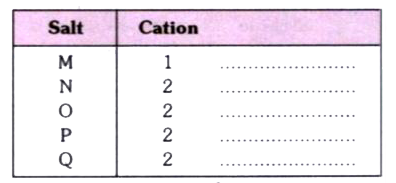Assertion: Alums are crystalline double salts, which are soluble in water.
Reason: The eq.solutions of alums have acidic character due to hydrolysis
If both assertion and reason are true and the reason is the correct explanation of assertion
If both assertion and reason are true and the reason is not the correct explanation of assertion
If assertion is false but reason is true
If assertion is true but the reason is false
The correct Answer is:B
To solve the question, we need to analyze both the assertion and the reason provided.
Step 1: Analyze the Assertion
The assertion states that "Alums are crystalline double salts, which are soluble in water."
- Explanation: Alums are indeed a type of double salt that can be represented by the general formula M2SO4·M'2(SO4)3·24H2O, where M and M' are different metal ions. They are known for their crystalline structure and are soluble in water due to the presence of water molecules in their formula.
Step 2: Analyze the Reason
The reason states that "The aqueous solutions of alums have acidic character due to hydrolysis."
- Explanation: When alums dissolve in water, they undergo hydrolysis, which leads to the formation of acidic solutions. This occurs because the metal ions (especially those from the aluminum group) can react with water to produce H+ ions, resulting in a solution with a pH less than 7, indicating its acidic nature.
Step 3: Conclusion
Both the assertion and the reason are true statements. However, the reason does not directly explain the assertion. The assertion is about the properties of alums being crystalline and soluble, while the reason discusses the acidic nature of their solutions due to hydrolysis.
Final Answer
Both the assertion and reason are true, but the reason is not the correct explanation for the assertion. Therefore, the correct option is that both statements are true, but the reason is not the correct explanation for the assertion.
---
The assertion states that "Alums are crystalline double salts, which are soluble in water."
The reason states that "The aqueous solutions of alums have acidic character due to hydrolysis."
Both the assertion and the reason are true statements. However, the reason does not directly explain the assertion. The assertion is about the properties of alums being crystalline and soluble, while the reason discusses the acidic nature of their solutions due to hydrolysis.
Both the assertion and reason are true, but the reason is not the correct explanation for the assertion. Therefore, the correct option is that both statements are true, but the reason is not the correct explanation for the assertion.
Topper's Solved these Questions
- s-BLOCK ELEMENTSBook:VK JAISWAL ENGLISHChapter:s-BLOCK ELEMENTSExercise:SUBJECTIVE PROBLEMS
Explore 2 Videos
- s-BLOCK ELEMENTSBook:VK JAISWAL ENGLISHChapter:s-BLOCK ELEMENTSExercise:MATCH THE COLUMN
Explore 6 Videos
- QUALITATIVE INORGANIC ANALYSISBook:VK JAISWAL ENGLISHChapter:QUALITATIVE INORGANIC ANALYSISExercise:SUBJECTIVE PROBLEMS
Explore 4 Videos
- TYPES OF REACTIONSBook:VK JAISWAL ENGLISHChapter:TYPES OF REACTIONSExercise:SUBJECTIVE PROBLEMS
Explore 42 Videos
Similar Questions
Knowledge Check
Assertion :Solubility of noble gases in water decreases with increases in atomic size
Reason :Solubility of noble gases in water is due to instantaneous dipole induced dipole interactionAIf both assertion and reason are true and reason is the correct explanation of assertion.BIf both assertion and reason are true but reason is not the correct explanation of assertion.CIf assertion is true but reason is false.DIf both assertion and reason are false.Assertion : The aqueous solution of CuSO4 is acidic in nature.
Reason : Copper sulphate is a salt of a weak base and a strong acid.AIf both Assertion and Reason are CORRECT and Reason is the CORRECT explanations of the AssertionBIf both Assertion and Reason are CORRECT but Reaon is not CORRECT explanation of the Assertion.CIf Assertion is CORRECT but Reasson is INCORRECT.DIf Assertion is INCORRECT but Reason is CORRECT.
Assertion: Sometimes a white turbidity is obtained when a solution is prepared in water.
Reason: Pb2+ catinos are precipitate as PbCl2 which is sparingly solution in water.
View SolutionAssertion (A): Aqueous solution of Na2CO3 is alkaline in nature.
Reason (R ): when dissolved in water, Na2CO3 undergoes anionic hydrolysis.
View SolutionAssertion (A): Aqueous solution of Na2CO3 is alkaline in nature.
Reason (R ): when dissolved in water, Na2CO3 undergoes anionic hydrolysis.
View SolutionSalts M, N, O, P and Q undergo reactiom (i) to (v) respectively.
Identify the cation present in these salts on the basis of these reaction. Tabulate your answer in the format given below.
1. When sodium hydroxide solution is added to the salt M, and heated strongly a colourless gas with a pungent smell is evolved which turm red litmus paper blue and gives dense white fumes with a moist glass rod with hydrochloric acid.
2. Addition of dilute hydrochloric acid to a solution of N gives a thick white precipitate which is soluble in hot water.
3. When ammonium hydroxide solution is added to the solution of 0 a light blue precipitate is obtained which is soluble in excess of ammonium hydroxide to form an inteme deep blue solution.
4. When ammonium hydroxide solution is added to the solution of P reddish brown (mustard colour) precipitate is obtained which ,is insoluble even in the excess of ammonium hydroxide solution.
5. When sodium hydroxide solution is added to the solution of Q a which coloured gelatinous precipitate is obtained which is soluble in excess of sodium hydroxide to form a clear solution

View SolutionWhich one of the following salts give an acidic solution in water ?
View SolutionAssertion (A): A certain recation is catalysed by acids and the catalytic activity of 0.1M solutions of the acids in water decrease in the order, HCI,HCOOH, and CH3COOH. The same reaction takes place in anhydrous NH3, but the three acids have same catalytic effect in 0.1M solution.
Reason (R) : The order of catalytic activity in water is the same as the order of acidity. in anhyrous NH3, all the three acids are strong.
View Solution